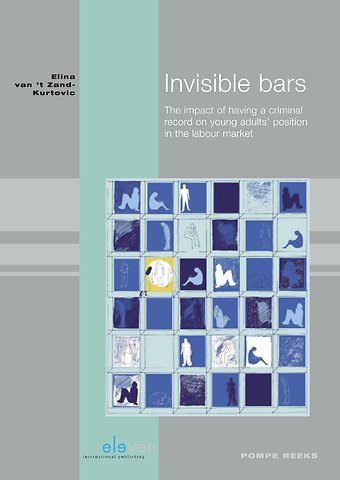Invisible bars
The impact of having a criminal record on young adults’ position in the labour market (PDF-Download)
Samenvatting
The emergence of a culture of control has led to rapid growth in the use of criminal-record screening in many Western-European societies over the last two decades. In the Netherlands, the number of screenings performed each year skyrocketed to almost one million. It is, therefore, salient that qualitative empirical evidence on the effects of criminal record-based employment restrictions is still absent. Invisible bars aims to fill this gap: it is designed to provide a subjective perspective of how having a criminal record impacts the process of re-entry into society, particularly into the labour market, for young adults.
This study is based on the lived experiences of 31 young adults having a criminal record, aged between 16 and 30, who were followed during their process of reintegration into the labour market for average periods of six to eighteen months. In addition, interviews with professionals and parents involved in their re-entry process offer in-depth insight in this process.
These actual experiences provide a thorough understanding of how crime, employment and reintegration are related. By offering vivid, real-life stories of young adults' strategies of dealing with the stigma of a criminal record, and how this subsequently influences their position in the labour market, this book will make it impossible to ignore the counterproductive effects of increasingly widespread criminal-record screening.
Trefwoorden
Specificaties
Inhoudsopgave
1 Research topic 1
2 Dearth of empirical data 2
3 Criminal records’ rising popularity 5
4 Punishment upon punishment? 7
5 Research framework 8
6 Summary 11
Chapter 2: The crime-employment relationship
1 Introduction 13
2 The effect of crime on work 13
3 The longstanding faith in work 17
3.1 Not just any job will do 17
3.2 High-risk individuals 19
3.3 Emerging adulthood 19
4 Summary and what’s next 20
Chapter 3: Legal framework
1 Introduction 23
2 Defining the criminal record 23
3 Storage and confidentiality 25
3.1 Privacy considerations 25
3.2 Storage periods 26
4 Criminal record-based employment restrictions 27
4.1 The certificate screening 27
4.2 Mandatory restrictions 28
4.3 Discretionary restrictions 29
5 Collateral consequences 31
5.1 Types and variations 31
5.2 Definitions 32
5.3 Justifications and limitations 32
6 Justifications and limitations of the Dutch system 34
6.1 Aims 34
6.2 Decision-making framework 36
7 Summary 39
Chapter 4: Theoretical framework
1 Introduction 41
2 Macro-level 42
2.1 Fuzzy law and jazzy structures 42
2.2 Security assemblages 43
2.3 Managing risk 44
2.4 Symbolic policies 47
2.5 Stigma vis-à-vis prevention 48
3 Meso-level 49
3.1 Responsibilisation 50
3.2 Managing risky groups 50
3.3 De-labelling rituals 53
3.4 Labelling without de-labelling 55
4 Micro-level 56
4.1 Labelling processes 57
4.2 Levels of stigma and coping strategies 58
4.3 Agency and narratives of desistance 59
4.4 Signalling desistance 61
4.5 Policy timing 62
5 Summary 63
Chapter 5: Research methods
1 A qualitative approach 65
2 Choosing respondents 67
2.1 Selection issues 67
2.2 Introducing the respondents 69
3 Collecting data 71
3.1 Primary data 71
3.2 Secondary data 75
4 Fieldwork in progress 77
4.1 Negotiating access 77
4.2 Trust 78
4.3 Informed consent 80
4.4 Letting go 80
5 Data quality 81
Chapter 6: Invisible obstacles
1 Introduction 83
2 Criminal histories 83
3 Definition of a criminal record 85
4 Obstacles to employment 87
5 Obstacles to education 92
6 No obstacles? 95
6.1 Don’t ask, don’t tell 95
6.2 Filling up the résumé gap 97
6.3 Pro-active disclosure 97
7 Certificate required (by law) 101
8 Conclusion 103
Chapter 7: Stigma
1 Introduction 107
2 Perceived stigma 107
3 The ‘ex-con’ label 110
3.1 A weighty and sticky stigma 110
3.2 A ‘bad name’ 112
4 Responses from officials 115
4.1 Placed on a ‘most notorious’ list 115
4.2 Police interference 118
5 Stigma’s origin 119
6 Emotional responses 121
7 Conclusion 124
Chapter 8: Self-exclusion and job prospects
1 Introduction 127
2 Self-exclusion 128
2.1 No certificate, no chance 128
2.2 Losing prospects 130
2.3 Taking the honourable way out 131
2.4 A strong self-selection effect 134
2.5 Self-exclusion in sum 135
3 Secondary deviance? 136
4 Job prospects 141
4.1 Not doing what they love most 142
4.2 Expecting marginal jobs 144
5 Conclusion 148
Chapter 9: Criminal record screening in a risk society
1 A macro-level perspective 151
2 Security assemblages and risk-governance 152
3 Prevention: from incapacitation to deterrence 157
4 The instrument’s effectiveness 160
4.1 Symbolic measures? 160
4.2 Safer businesses but no safer society 160
4.3 Signalling desistance 163
5 Justifications and limitations 165
5.1 The offence-occupation connection 165
5.2 Serious risk of serious harm? 165
5.3 Individualised decisions 167
5.4 Judicial review 168
6 Conclusion 169
Chapter 10: Agents of rehabilitation
1 Rehabilitation as two-way process 171
2 Experts’ key role 172
3 Responsibilisation 174
4 Managing risky groups 179
4.1 Declining role of experts 179
4.2 Objectified risk assessment 182
5 Leniency for youthful sins? 183
5.1 Short expiry periods 183
5.2 Dropouts and too negative expectations 184
6 Active rehabilitation 186
7 Conclusion 188
Chapter 11: Conclusion
1 Invisible bars 191
2 Consequences of a criminal record 192
2.1 Being labelled 192
2.2 Collateral consequences 193
3 Stigma of a criminal record 194
3.1 Unanticipated stigma 194
3.2 ‘Doing time’ 195
3.3 Anticipated stigma 196
3.4 Self-exclusion 196
4 Justifications and limitations 197
4.1 (In)eligible for a certificate 197
4.2 Judicial review 198
5 One million and beyond 199
5.1 Managing risky groups 199
5.2 A very slight effect 200
6 Towards incentivised rehabilitation 201
Summary 203
Samenvatting 209
References 223
Appendix 1: Short introduction to the respondents 235
Appendix 2: Topic list 243
Appendix 3: Interviews with professionals and/or parents 245
Appendix 4: Codebook used for coding the interviews with the young adults 247
Curriculum vitae 251
Anderen die dit e-book kochten, kochten ook
Rubrieken
- cadeauboeken
- computer en informatica
- economie
- filosofie
- flora en fauna
- geneeskunde
- geschiedenis
- gezondheid
- jeugd
- juridisch
- koken en eten
- kunst en cultuur
- literatuur en romans
- mens en maatschappij
- naslagwerken
- non-fictie informatief/professioneel
- paramedisch
- psychologie
- reizen
- religie
- schoolboeken
- spiritualiteit
- sport, hobby, lifestyle
- thrillers en spanning
- wetenschap en techniek
- woordenboeken en taal









